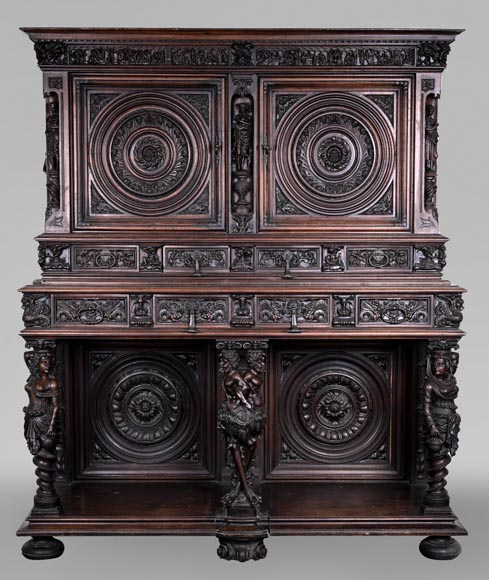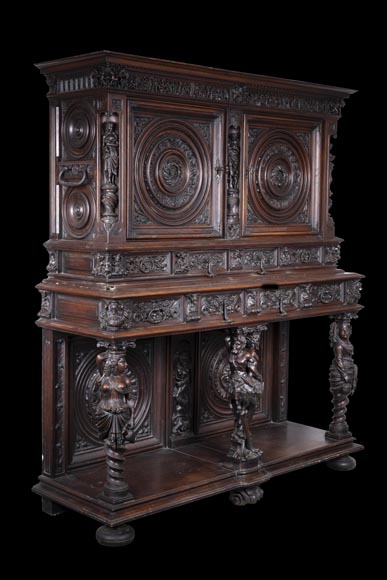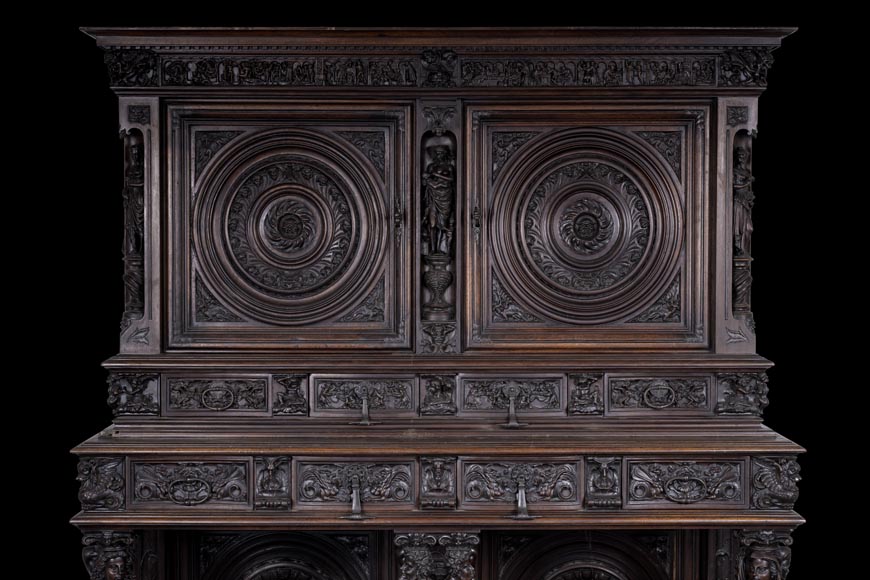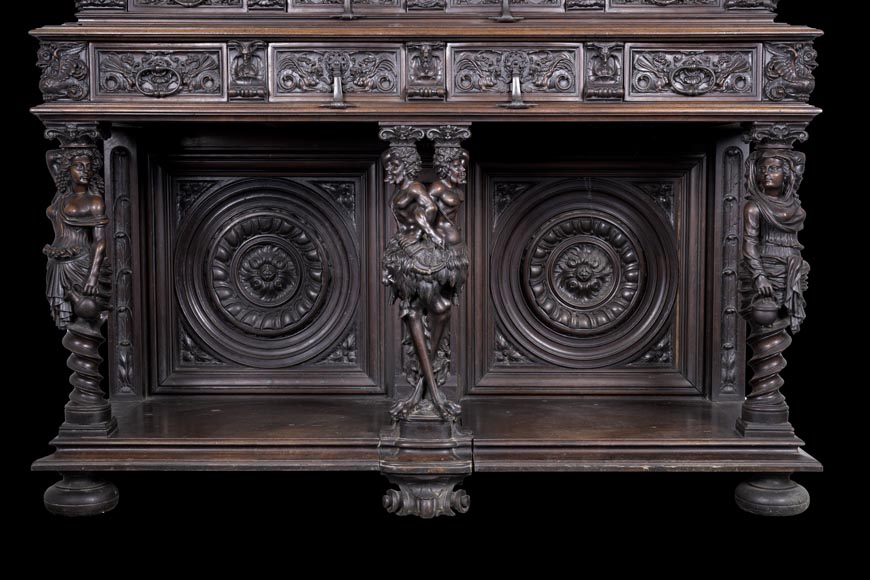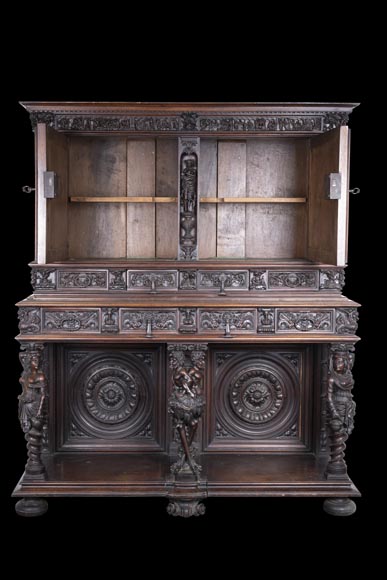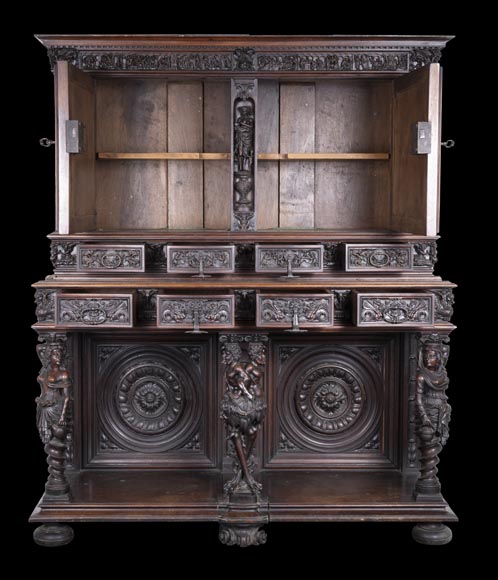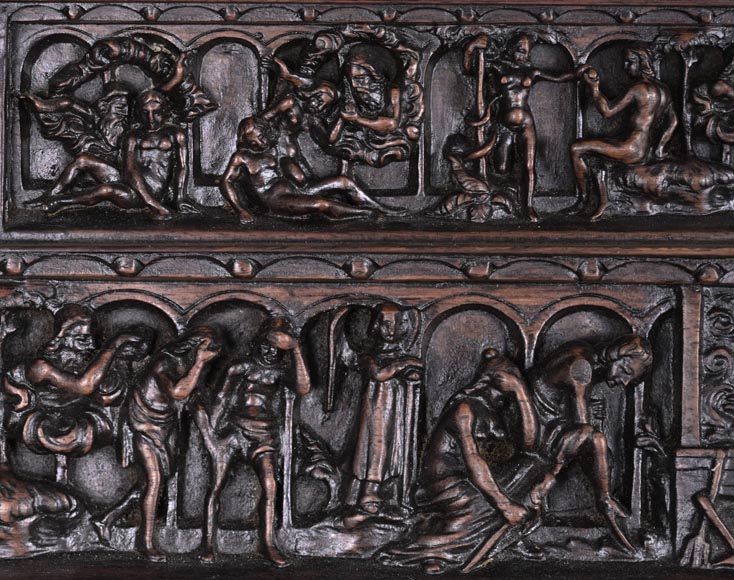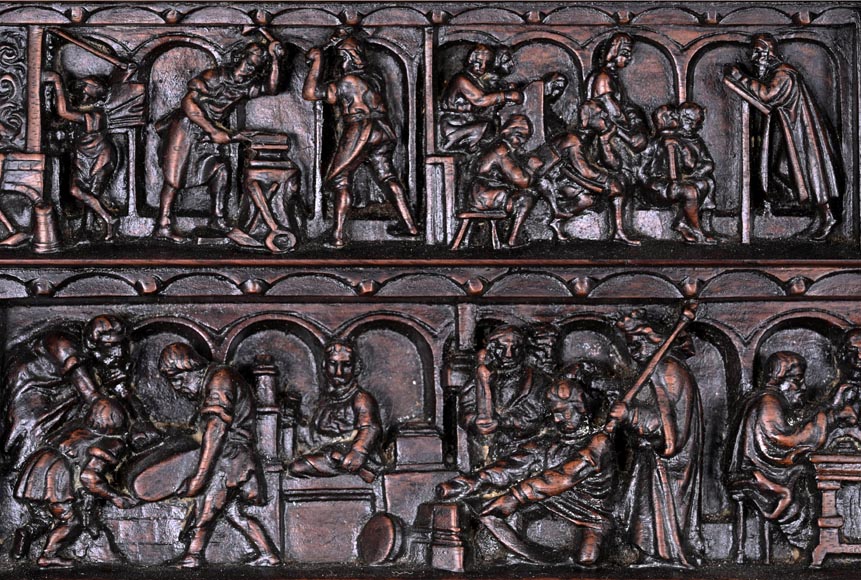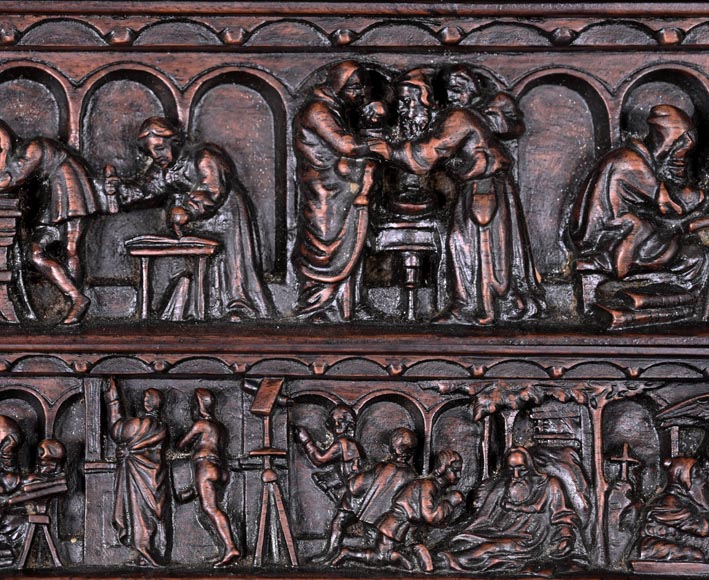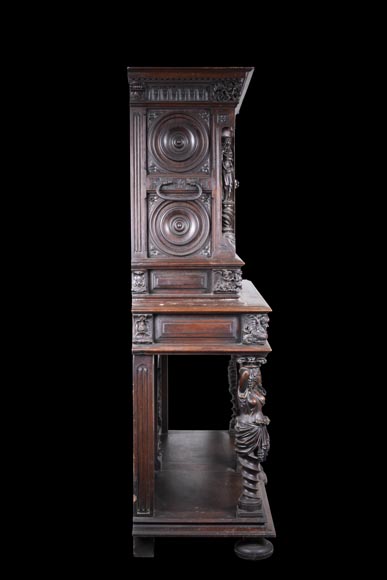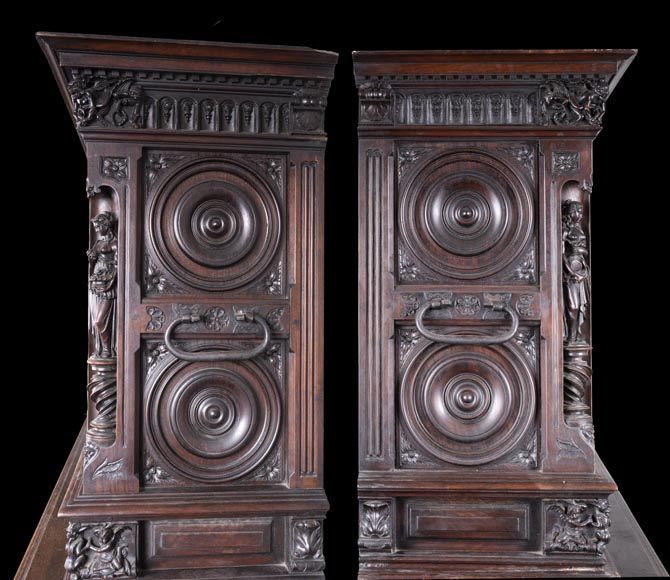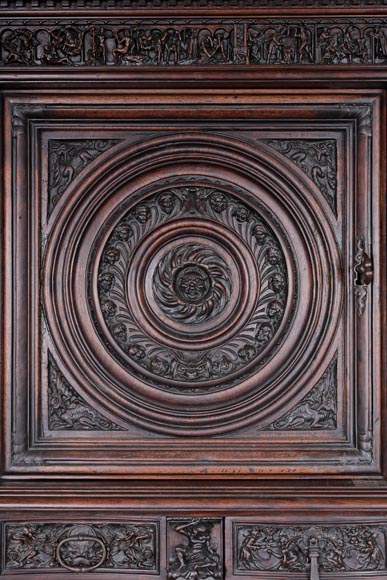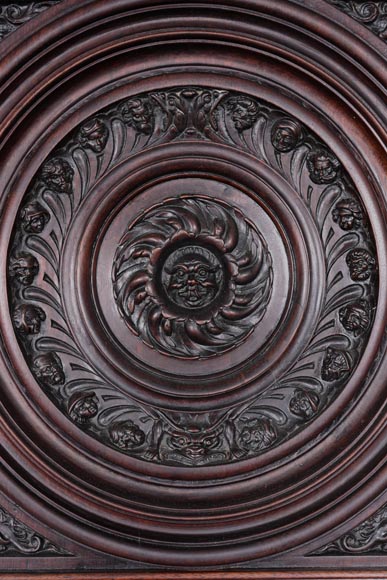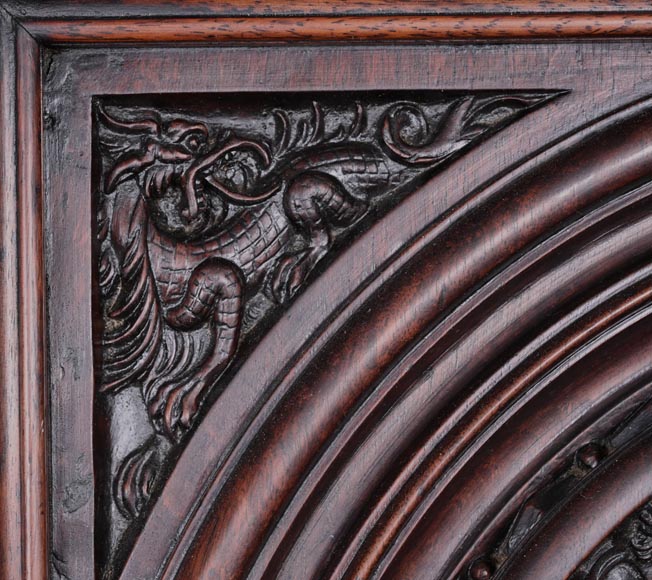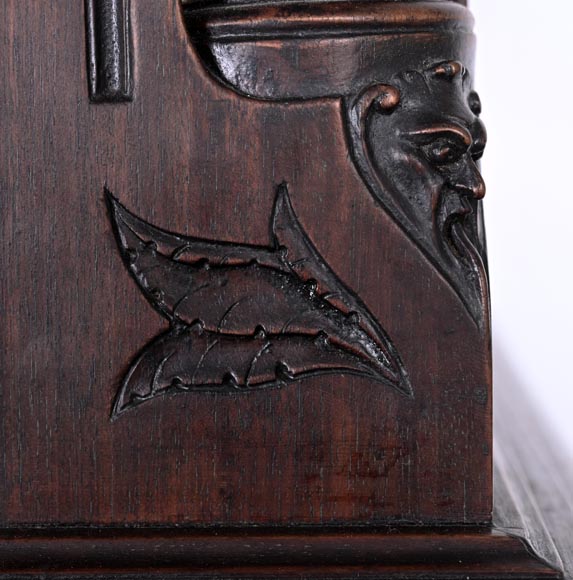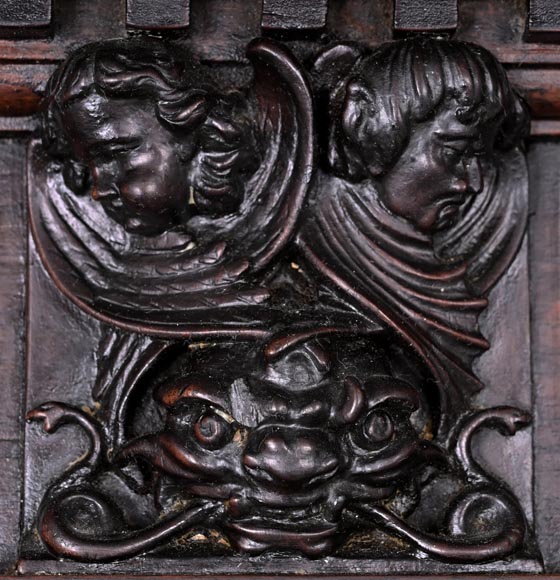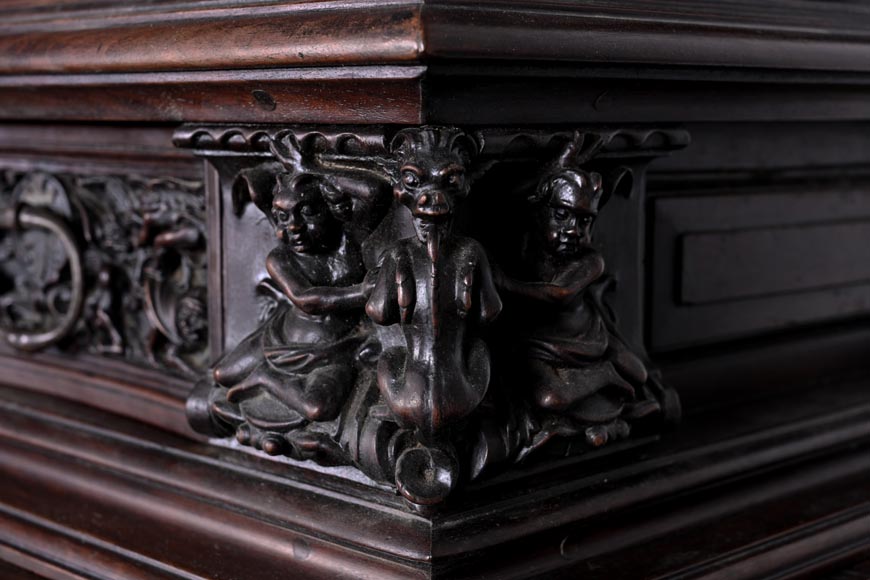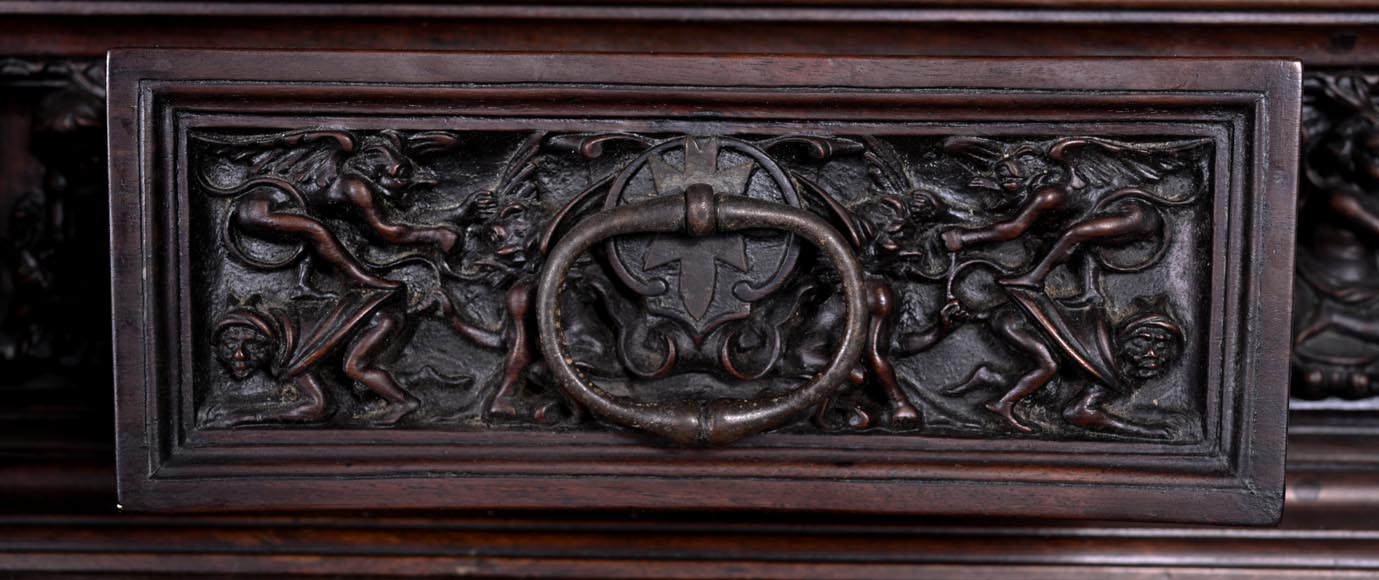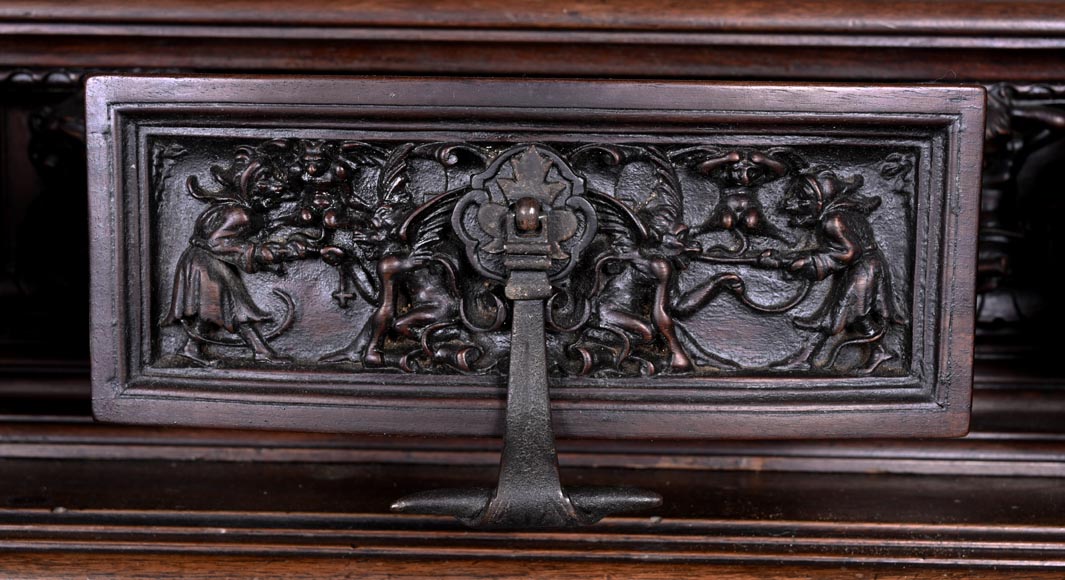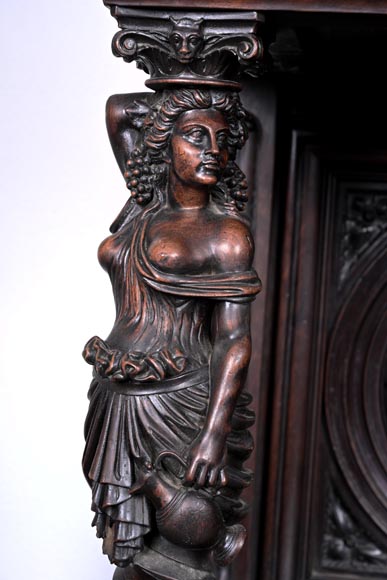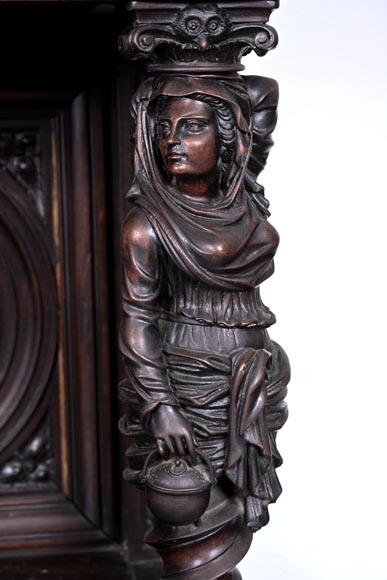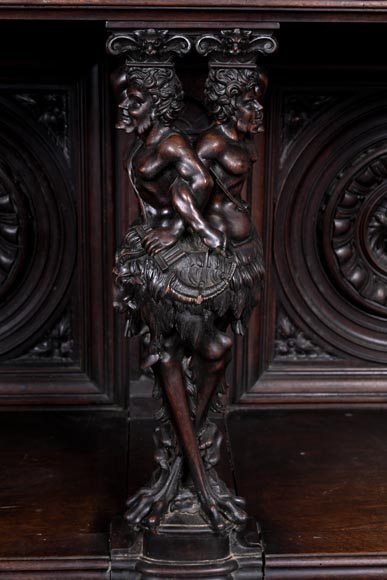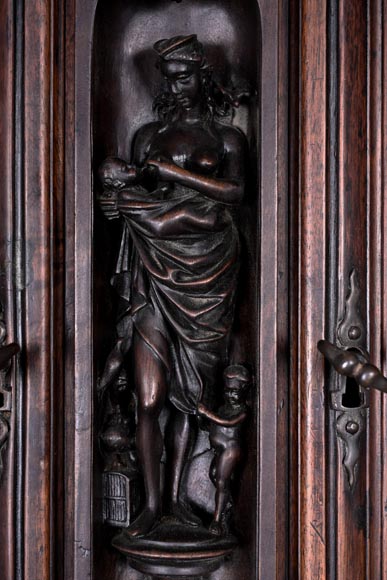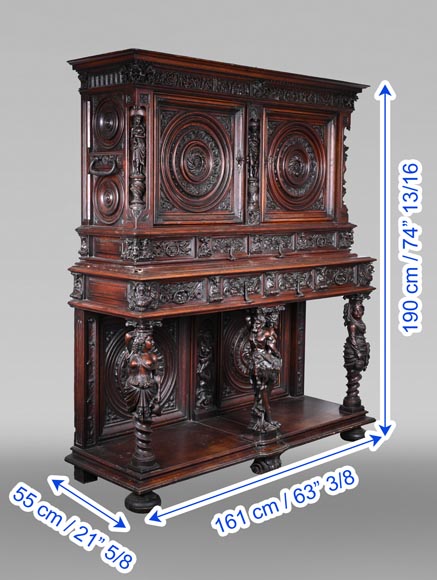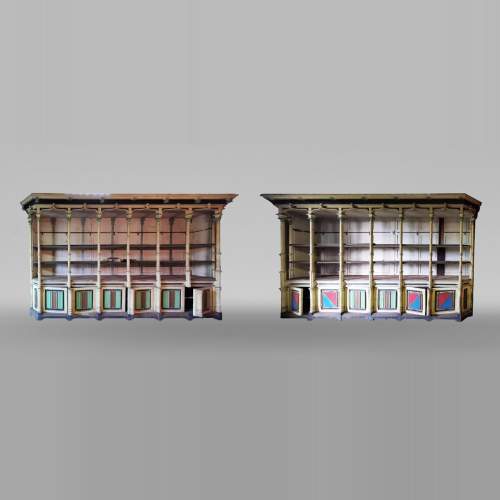Style Neo-gothic / Ref.15877
CHIMERIC DRESSOIR
Dimensions
Width 63'' ⅜ 161cm
Height 74'' ¾ 190cm
Depth: 21'' ⅝ 55cm
This imposing walnut carved cupboard sideboard is a tour de force of artistic invention and technical mastery. Close to Tuscan Neo-Renaissance production of the second half of the 19th century, this exceptional piece brilliantly blends Renaissance vocabulary with diabolical iconography. Resting on five feet, the four-sided base develops a moulded plinth and features three tall anthropomorphic supports holding the main body. The back panel is adorned with low-relief rosettes. Two rows of four richly carved drawers are stacked. The second level, slightly recessed, serves as the base for the juxtaposed doors, separated by a female sculpture in a niche. The lateral uprights are also decorated: target motifs, iron handles, chimeras, and female corner figures. This fantastical sideboard is topped with a frieze representing scenes from the Old Testament. An antique-style cornice crowns the ensemble.
At the Sources of Historicism and the Neo-Renaissance Style
The decorative arts and architecture of 19th-century Europe are marked by an uninterrupted succession of historicist styles: Neo-Classical, Neo-Gothic, Neo-Romanesque, Neo-Renaissance, Neo-Byzantine… The deliberate use of models and forms borrowed from the past is one of the defining features of Historicism. Chimeras, scrolls, caryatids, and mascarons constitute the decorative repertoire of the Neo-Renaissance style, largely influenced in France by the rediscovery of the 16th-century Burgundian cabinetmaker Hugues Sambin. Appreciated by the public as early as the 1840s, the reign of Napoleon III marked the rise of this artistic movement. The 1867 Exposition Universelle celebrated the apogee of the style; on this occasion, Henri-Auguste Fourdinois produced his famous two-tier cabinet, now in the Musée des Arts Décoratifs in Paris (inv. 29921). In France, the designation “Henri II style” actually refers to a diverse production – just as in Italy, the stile umbertino expressed strong Renaissance influences. The taste for the Neo-Renaissance style was particularly strong in Italy, where it accompanied the construction of national identity: artists and intellectuals aspired to make it a specifically Italian style. In 1883, the theorist and architect Francesco De Cesare asserted in Dello stile architettonico proprio italiano that the Neo-Renaissance style was the most suitable for the Italian people because it had the dual benefit of being ancient and transcending regionalism. The growing interest in this aesthetic went hand in hand with a new historical consciousness: the young Italian nation thus adopted the decorative repertoire of a glorious period in its past.A Tuscan chimeric dressoir
Between Siena and Florence, starting in the 1860s, the workshops of Bartolozzi and Ferri, Egisto Gajani, Angiolo Barbetti and his pupil Pietro Giusti, Pietro Cheloni and Luigi Frullini produced important pieces inspired by the Renaissance ornamental repertoire. Inventions, reappropriations and pastiches were presented by Tuscan cabinetmakers at the Universal Exhibitions of 1876 and 1878.
Inspired by contemporary and earlier creations, our sideboard is an exercise in style demonstrating great technical mastery. The artist brilliantly uses Renaissance and Neo-Gothic ornamental vocabulary to create a piece of furniture of great originality. Much more than a piece of furniture, this piece is a theatre stage where dark and evil forces are staged, pursuing the damned souls.
Two monsters are depicted on the panels: the first in the centre of the rose window, the second in its lower centre. They can be compared to the figure depicted on the capital of the monumental walnut bench created by Giovanni Sammicheli between 1895 and 1897, or to the one adorning the lower edge of Egisto Gajani's frame, sculpted in Florence in 1871. In the centre of the upper part of the dresser, a monstrous head with snakes for moustaches has similar features. The infernal circle of rosettes described by highly individualised faces culminates at the top in a two-faced mouth of hell ready to devour tormented souls. In keeping with the tradition of Gothic sculptors, the artist illustrates the threat of eternal damnation that hangs over all men, regardless of their rank or wealth.
The use of dragons in the spandrels of the door panels is similar to the formal solution adopted by Pietro Giusti in 1862 in his walnut frame preserved at the Victoria & Albert Museum. The curved pediment with false opening features an angelic face surrounded by wings – a motif similar to the centre of the rosettes on the door panels of our furniture. Undoubtedly inspired by Giusti, our artist surpasses him in his virtuoso rendering of the angel and demon enveloped in their wings at the centre of the historical frieze.
The taste for fantastical creatures is evident in the cabinet made in 1869 by Francesco Morini, where Atlantean figures are separated by an unsettling mask adorned with ram's horns. Similar to this example, Atlantean figures adorn the drawers of the upper section of our piece and support the main body of the cabinet, carried away by demons in the outer corners. The diabolical iconography is reflected in borrowings from the Gothic register: in the manner of historiated capitals, fantastical creatures resembling gargoyles fight over human souls. The artist depicts amusing scenes on the drawers in which demons lead the damned, who seem to take on their physical features. Leaning against the central medallion, winged demons fight bird-headed monsters, pulling the tails of unfortunate, deformed beings crouching below. Other scenes carved on the drawers seem to represent a battle between good and evil: a monkey dressed in a monk's robe holds a crucifix pulled by a monster, while another pulls on a rope to which a crucifix could be attached and swallowed by the chimera. In these grotesque scenes, the sculptor gives religious figures simian features, a common technique in critical representations of humanity.
Inspired by antiquity, the caryatids on the lower part of the sideboard echo the scalloped base of Francesco Poccetti's torch holder, preserved at the Palazzo Pitti (fig. 9.a and 9.b), while the lower limbs of the accompanying fauns take the form of powerful claws. The faces of these disturbing satyrs borrow heavily from the Mephistophelean register: pointed noses and beards, emaciated faces, dishevelled hair and elongated ears. This sideboard is an ambivalent theatre where the feverishness of humanity confronts powerful dark forces. The owl heads skilfully nestled in the capital above the fauns bear witness to this: an animal of great intelligence capable of seeing in the dark, it is a traditional iconographic attribute of both wisdom and madness. In the centre of the back panel, a naked woman victorious over a demon mimics the archangel Michael. At the top of the sideboard, from left to right, a frieze depicts the creation of man and woman, their expulsion from the Garden of Eden, the labours of the first family and the life of a saint carried away by an angel, a faint glimmer of hope in this piece of furniture with its infernal accents.
The female figures in the niches display domestic and rustic attributes that contrast with the rest of the décor: jug, pot, flowers, sickle. In the centre of the sideboard, on a baluster-shaped support, a mother breastfeeds her child while a young boy pulls on her dress and another releases a bird. The formal and material similarities – use of walnut, density of the composition, Renaissance-inspired motifs – allow us to compare our sideboard with the works of Angiolo Barbetti, Pietro Giusti, Carlo Bartolozzi, Nicodemo Ferri and Luigi Frullini. These clues suggest that it dates from the second half of the 19th century and was produced in Tuscany.
Informations
Price: on request
Recommended for you :
Dimensions:
Width: 520
Height: 282
Depth: 70
Dimensions:
Width: 53
Height: 138
Depth: 34
Dimensions:
Width: 132
Height: 74
Depth: 77
Dimensions:
Width: 79
Height: 157
Depth: 35
Dimensions:
Width: 83
Height: 179
Depth: 45
Dimensions:
Width: 100
Height: 173
Depth: 47
Dimensions:
Width: 141
Height: 73
Depth: 70
Dimensions:
Width: 131
Height: 145
Depth: 48
Dimensions:
Height: 228
Diameter: 88
Dimensions:
Width: 114
Height: 130
Depth: 49
Dimensions:
Width: 78
Height: 186
Depth: 47
Dimensions:
Width: 110
Height: 173
Depth: 44



